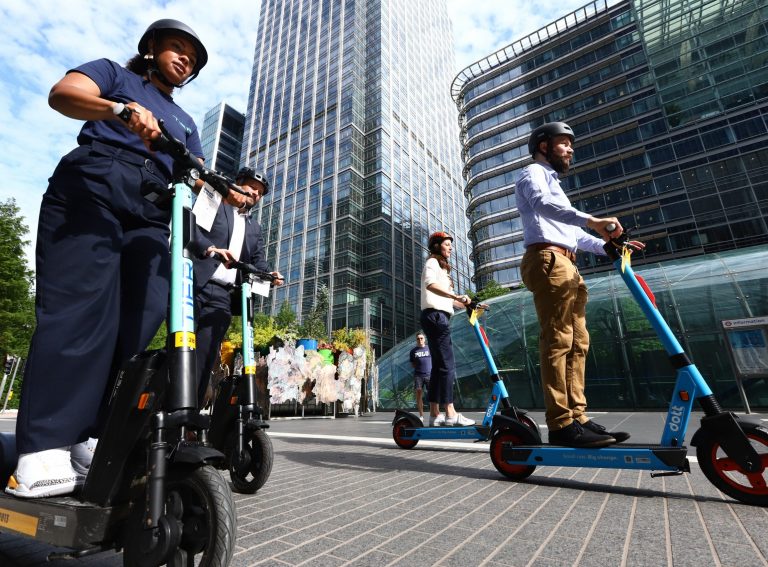“Imagine a shared bike where you just jump on and start cycling. Everything automatically unlocks, you set off, and it starts billing you.”
That’s what Luna Systems CEO Andrew Fleury envisions for the future of software-defined-vehicles in micromobility.
The tech’s already there for shining star Tesla, the so-called ‘computer on wheels’ with everything managed through one central infotainment screen, and now two-wheelers are eagerly following suit.
For micromobility the time is now, Andrew says.
No cumbersome unlocking process, no time wasted faffing around – just pick up a shared bike or e-scooter and go. Facial recognition, Bluetooth detection, bring it all together and enable a digital two-wheeler riding experience with the ease of a smartphone.
“How magical would that be?”
Zoomed in – Computer vision
Irish tech firm Luna Systems has been using AI-powered computer vision to improve the management of micromobility fleets.
Last year, Qualcomm Technologies announced a partnership with Luna to deploy advanced rider assistance systems (ARAS) solutions into its Snapdragon Digital Chassis. Features such as Forward Collision Warning and Headway Monitoring were installed to give riders crucial time they needed to safely manoeuvre.
A joint study between Luna and Dott saw AI-powered cameras fitted into Dott scooters to understand the rationale behind pavement riding.
Computer vision has been instrumental for Luna in informing cities of dangerous hotspots and curbing errant riding behaviour across the world from the UK to Japan, France, Israel, Belgium and Ireland.
With tech comes data, and this data is helping bridge operators with cities, enforce regulations and uphold safety.
But what if there could be more?
Zoomed out – the software-defined-vehicle
A software-defined-vehicle is one that can be continuously updated throughout its lifetime, with new applications and functions integrated.
For new mobility, one such application is an algorithm which automatically reports poor road and pavement conditions to local councils.
“You’ve just noticed a manhole cover which is cracked and broken, and luckily you’ve swerved it. Now this can be reported back to the city without the bike user having to do anything, and it can be fixed for the next person,” Andrew said.
“Some councils need you to take photos of the problem and then submit them. No one uses them and nothing gets done.
“It’s much easier if you have this automated reporting where computer vision acts as your eyes and is feeding what you’re seeing back to a database.”
OTA updates could also be used to tackle parking violations.
In 2022, for example, New York City proposed a bill that would reward New Yorkers who report parking violations with 25% of the $175 fine.
“This is a little bit out there,” Andrew says. “And the message isn’t to automate fines. But with this technology we could very easily detect cars encroaching on bike lanes and send that data back to the city.”
You don’t need to look too far to see the other potential applications of OTA updates. Take Paris which last month voted in favour of tripling parking charges for SUVs in the city centre. Algorithms in software-defined-vehicles could classify different vehicle sizes in the centre and serve the information back to the city.
What other players are doing
Belgian e-bike maker Cowboy is one player that shares Andrew’s vision for software-defined vehicles.
Its recent e-bike launch Cross integrates Google Maps navigation – a partnership that only Cowboy can boast in the industry – to send ‘Predictive Alerts’ to the rider when approaching dangerous hotspots.
“We use crash data to detect dangerous crossroads and let riders know about them in advance,” Cowboy Co-Founder Tanguy Goretti tells Zag.
The rider will also receive alerts when they’re in a zone that has high theft rates, and the app will inform them of where there is a safe parking place to securely park the vehicle.
Despite the newly announced technologies, Tanguy is already looking ahead at the potential of software-defined micromobility.
“The bike industry is still 5 to 10 years behind the car or smartphone industry,” Tanguy says.
“When the first smartphone was introduced everyone was competing for the hardware. A few years later and the hardware hasn’t really changed, but rather the real difference is in the software.
“The next big thing which may not come for years is vehicle-to-vehicle communication.”
One V2X application that Tanguy suggests is sending a car driver an alert before they open their car door. The alert might ask them to check if a cyclist is approaching from behind, and it might also delay the car doors unlocking by a few seconds.
“Every time you open your car door you put a cyclist’s life in danger.
“V2X is going to take time and I have no idea how it will look in production. But from a safety perspective it will be a huge advantage.”





